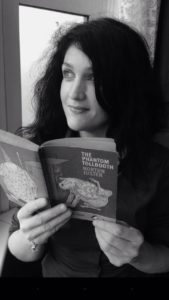A light and enjoyable novel following 10 year old Grace Elizabeth through the neighbourhood’s secrets, enlightenment, an other revelations. Some nimble nuggets of insight into the prejudices and solidarity within a 70s suburban street while she perseveres on her ‘search for Jesus’. Flawed, but certainly cleverer than it seems at first glance.
The Trouble with Goats and Sheep does conjure to mind words like ‘charming’, ‘coming-of-age’, and ‘delight’, as quoted from reviews that rave about the book’s ‘innovation’. All the same, it is somehow both less and more than this. More because the writing really is something to revel in, and at times neither simply ‘charming’ nor ‘delightful’ but acerbic, insightful, playful and skilful.
Tilly didn’t notice, but I saw them straight away. A tribe of girls, a uniform of Quatro flicks and lip gloss, with hands stuffed into pockets, making denim wings. They stood on the opposite corner, doing nothing except being older than me. I saw them weigh out our presence, as they measured the pavement with scuffed market boots and chewed gum. They were a bookmark, a page I had yet to read, and I wanted to stretch myself out to get there.
…. I grew the distance between us, as stares filled with opinion reflected back at me. I couldn’t find anything to do with my arms, and so I folded them around my waist and tried to make my sandals sound more rebellious. Tilly waited for me around the corner … ‘Why are you talking like that?’…
Precocious ten-year old Grace, together with her side-kick and best friend, Tilly, recall something of the innocent nostalgia of Enid Blyton’s young detectives as they set out through ‘The Avenue’ of this small suburban 70s town to uncover the mystery of the disappearing neighbour… Along the way, Grace reveals more than she bargained for – something naturally more apparent to an adult reader than to Grace herself – as each household seems to hold a secret of its own. She begins to learn to interpret some of the signs along the way and, increasingly, even the dynamics of the relationships around her.
While it might not be original to tell a tale through the eyes of a child, her very literal understanding of expression ‘God being everywhere’ (‘You just have to look’) becomes her vital mission and the double-entendres abound. Despite the subject matter and Grace’s ‘Quest’, the novel tries to avoid sermonising, merely musing on attitudes or religious meaning, and remains playful; starting with the heroine’s name. Even the Gardener/ Jesus metaphor, though obvious, (‘The most important thing a garden needs is the shadow of a gardener’) is endearing rather than heavy-handed. Mostly it is through Grace’s naivety that we can appreciate Cannon’s combination of humour and wry critique:
I glanced around and realised there were lots of people standing on pieces of wood, looking down on us. It was confusing, because they all looked thoughtful and slightly disappointed, and all of a sudden it wasn’t really very clear at all which one was Jesus.
I did have a small complaint though. The heading of the chapters – jumping back and forth between the houses, (all on ‘The Avenue’), the dates and different voices (past and present; first person and third) began to grate a bit. It seemed more contrived than necessary and suffered the narrative to be disjointed at times. Understandably, in order for Cannon to examine all the ‘trapped […] thoughts behind a frown’ she has decided to examine each character ‘behind doors’, in addition to using Grace’s own voice. Perhaps if all the voices including Grace’s were in third person, or if Grace had told the complete story from her perspective this might have helped give it a continuity that would have required my empathy. As it was, I found I was flipping between the chapter titles (woe betide those who read it on an e-book!) and getting increasingly distracted and irritated.
The book’s real allure lies with the use of language, which is at times is poignant and evocative, delving into moments of pathos and distress. It is these nuanced observations that I found most interesting and which gave the story a counterbalance of gravity and momentum.
He had tried to carve into the quiet with the television and the radio, and the sound of his own voice, but his noise just seemed to grow the silence and make it taller, and it followed him from room to room, like water pouring from a glass.
Since she’d disappeared, he’d noticed that the silence happened everywhere.
and
I could see my mother measuring out her afternoon at the kitchen sink.
And yet, despite Cannon’s assiduity of the characters, I felt they would have benefited from an extended study: currently they seem to be only sketched portraits waiting to be coloured with deeper shades of light and dark. Unlike Mark Haddon’s Curious Incident of the Dog in the Night-Time which is told completely from the perspective of an innocent voice, ‘The Trouble with Goats and Sheep’ combines its narration amongst all the characters. This tends to dilute the impact of the various threads and characters which seem so full of potential. Perhaps I’ve been reading too many 19th century novels, but I feel like The Trouble with Goats and Sheep would have benefited from more pages. It is good enough to warrant more words, certainly.
The Trouble with Goats and Sheep by Joanna Cannon is published by The Borough Press, 464 pages.
FURTHER READING SUGGESTIONS:
- Curious Incident of the Dog in the Night-Time by Mark Haddon
Another ‘mystery’ solved by an ‘innocent’ – in this case, the protagonist is the 15 year old Christopher who has Asperger’s syndrome – also unravelling with it its own set of skeletons in the cupboard. (click here for snap judgement)
- Casual Vacancy by J. K. RowlingA much darker portrait (than The Trouble of Goats and Sheep) into the myopic machinations and petty grievances of the inhabitants in this idyllic English village. Written to perfection. (review to follow)





